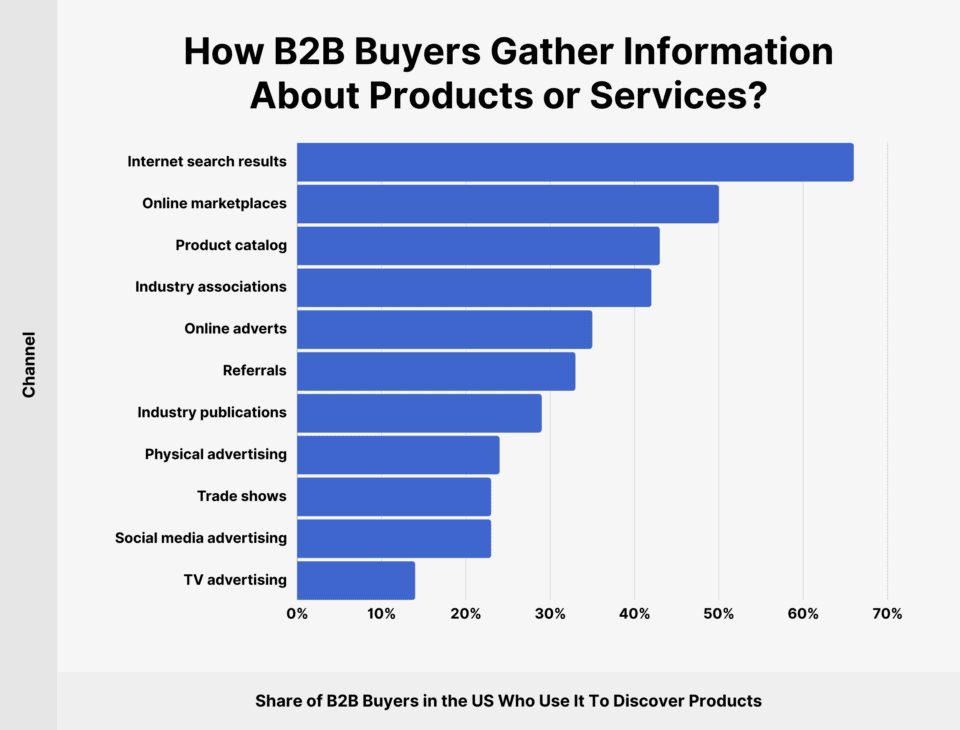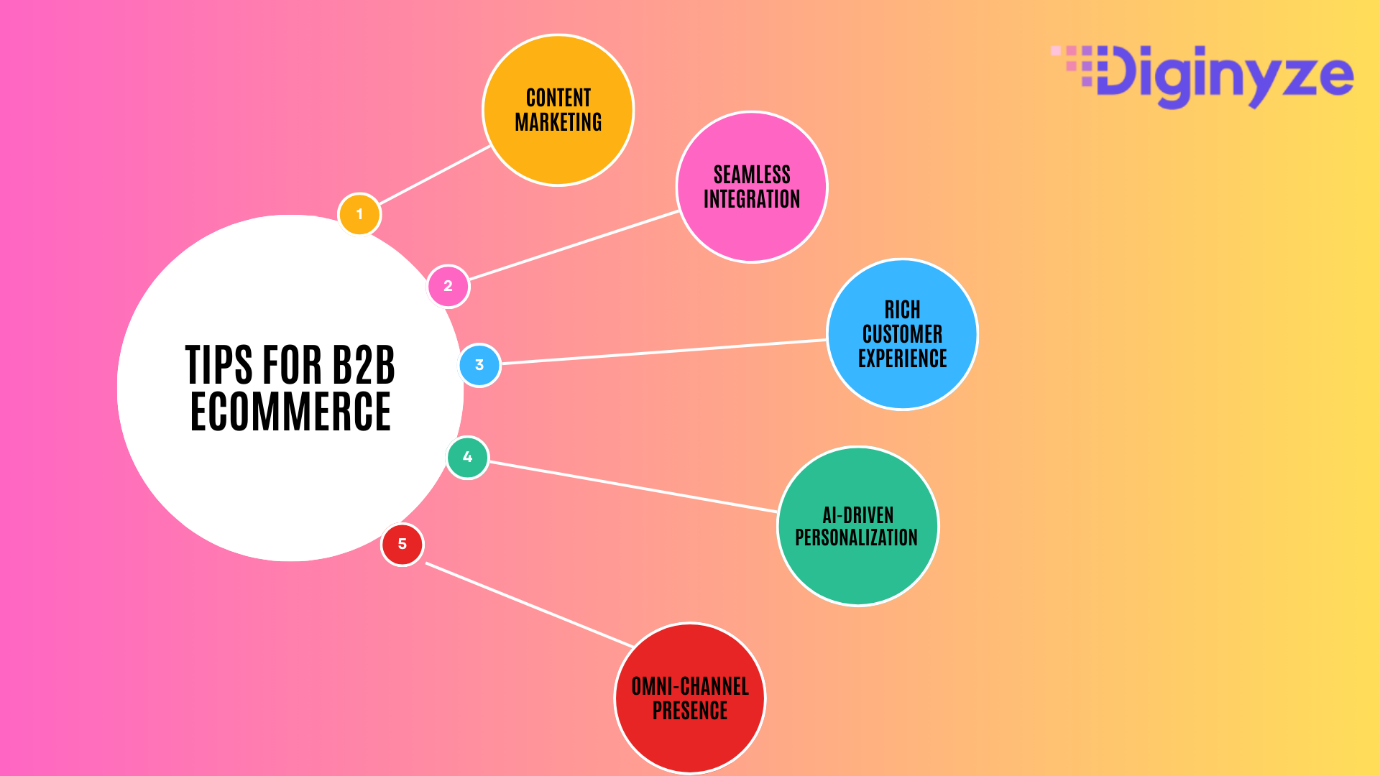
The world of B2B eCommerce is changing fast. More companies are moving their business online and having a strong digital presence is now essential. When your eCommerce website is well designed and optimized, it helps you reach more customers, simplify your sales process and grow your revenue.
Today’s B2B buyers expect the same smooth and convenient experience they get when shopping as consumers. They look for easy navigation, helpful product suggestions and a simple, hassle-free checkout. When you meet these expectations, you not only make your customers happy you also increase conversions and build lasting relationships.
Did you know?
90% of B2B buyers start their purchase journey with an online search.

Source: Backlinko
Key Steps to Building a High-Converting B2B ECommerce Website
Creating a B2B eCommerce website that drives sales requires more than just setting up an online store. Here’s a step-by-step guide to launching a platform that stands out:
1. Choose a Strong Brand Identity and Secure a Domain
Your business name and domain should reflect professionalism, credibility, and clarity. A well-chosen domain name enhances trust and makes it easier for buyers to find you.
2. Define Your Business Model and Target Audience
Clearly outline your business scenarios, target customers, and use cases. Are you selling directly to businesses, distributors, or wholesalers? Understanding your audience's needs will help shape your website's structure and functionality.
With 52% of B2B buyers expecting to make at least half of their purchases online in the next three years, identifying their pain points and habits early on gives you a head start.
3. Select the Right B2B ECommerce Platform
Your choice of an eCommerce platform can make or break your success. Opt for a scalable, AI-powered platform that supports advanced features like personalized pricing, bulk order management, and automation. Also the platforms provide flexibility and intelligent automation to streamline operations, making it easier to manage a growing B2B business.
4. Optimize User Experience (UX) and Website Design
A user-friendly interface is critical for B2B buyers who expect efficiency and ease of use. Your website should offer:
-
Intuitive Navigation: Clear categories, search functionality, and quick order forms.
-
Mobile Responsiveness: Ensure a seamless shopping experience across devices.
-
Customization and Personalization: AI-driven product recommendations and personalized pricing based on user behavior.
According to market research 86% of decision-makers prefer self-service tools over human interactions for reordering, these elements become non-negotiable.
5. Integrate Essential B2B Functionalities
To provide a smooth purchasing experience, integrate tools that enhance efficiency and customer satisfaction:
-
Flexible Payment Options: Credit terms, invoicing, and multiple payment gateways.
-
Seamless Order Management: Automated tracking, bulk ordering, and multi-tier pricing structures.
-
CRM and ERP Integration: Streamline business processes by connecting with your existing CRM and ERP systems.
-
Self-Service Portals: Give buyers the ability to manage their accounts, track orders, and reorder easily.
6. Leverage AI and Automation for Efficiency
Automation is a game-changer in B2B eCommerce. AI-powered platforms can help:
-
Predict customer needs: Provide AI-driven product recommendations.
-
Optimize pricing strategies: Offer dynamic pricing based on demand and purchasing history.
-
Automate marketing workflows: Personalized email campaigns and retargeting.
7. Implement Strong SEO and Digital Marketing Strategies
To drive traffic and sales, invest in:
-
SEO Optimization: Use AI-powered marketing tools for keyword research, meta tags, and structured data to improve search engine rankings.
-
Content Marketing: Create valuable resources like whitepapers, case studies, and blog posts.
-
Social Media and Paid Advertising: Run targeted LinkedIn and Google Ads campaigns to attract potential buyers.
8. Provide Exceptional Customer Support
B2B transactions often involve higher order values, making customer support crucial. Consider:
-
Live Chat and Chatbots: AI-powered chatbots can answer common queries and assist buyers in real time.
-
Dedicated Account Managers: Offering personalized assistance builds stronger client relationships.
-
Comprehensive FAQs and Knowledge Base: Reduce friction by providing self-service resources.
9. Customer Segmentation & Tiered Access
B2B businesses often cater to diverse customer segments. Enable role-based access to display specific catalogs, pricing, and offers tailored to different customer groups, such as wholesalers, retailers, or distributors.
10. Inventory and Supply Chain Visibility
Provide real-time stock updates, estimated delivery times, and transparent supply chain tracking. This builds trust and enables customers to make informed purchasing decisions.
11. Request for Quote (RFQ) Functionality
Many B2B buyers prefer to negotiate pricing for bulk orders. Include RFQ options that allow customers to submit quote requests directly from the product or cart page.
12. Advanced Security Features
Security is paramount in B2B eCommerce. Implement two-factor authentication, SSL encryption, and compliance with data privacy regulations like GDPR and CCPA to protect sensitive business data.
13. Reordering and Subscription Models
Simplify recurring purchases with reorder buttons, saved order templates, and subscription options for frequently ordered products.
14. Tax Handling and Compliance
Automate tax calculations with support for regional requirements such as VAT, GST, and tax exemption certificates, ensuring full compliance across markets.
15. Localization and Language Preferences
Cater to international clients with multilingual support, local currencies, and region-specific pricing and content.
16. Headless Commerce Option
Adopt headless commerce architecture for maximum flexibility. This allows businesses to build custom front-end experiences while retaining a powerful back-end system.
Also Read: Revolutionizing B2B eCommerce: The Power of AI-Driven Search

Choosing the Right Platform for Your B2B eCommerce Store
Selecting the right eCommerce platform is crucial for long-term success. Diginyze, an AI-powered eCommerce solution, is designed to help B2B businesses scale efficiently. Its advanced features include:
-
AI-Driven Personalization: Deliver tailored experiences and product recommendations.
-
Seamless Automation: Automate order management, marketing, and pricing structures.
-
Scalable and Customizable: Adapt the platform to your unique business needs.
-
Omnichannel Capabilities: Manage sales across multiple touchpoints, including web, mobile, and marketplaces.
-
Advanced SEO and Marketing Tools: Improve visibility and conversions with built-in AI-powered SEO tools.
-
Multi-Store and Multi-Currency Support: Expand into global markets effortlessly.
Also Read: Revolutionizing eCommerce The Power of Automation and Diginyze
Future-Proof Your B2B Business with a Robust eCommerce Strategy
The future of B2B commerce is digital. Businesses that invest in an AI-powered eCommerce platforms will gain a competitive edge. By leveraging automation, personalization, and data-driven insights, you can create a seamless and high-converting B2B shopping experience.
Ready to take your B2B eCommerce business to the next level, explore how Diginyze can help you build, optimize, and scale your online store. Book a free demo today!
Recent Blogs
Explore latest insights and trends in technology and eCommerce.
Case Studies
Your Digital Transformation Starts Here!
Join thousands of businesses transforming with Diginyze. Sign up today and start now!


























